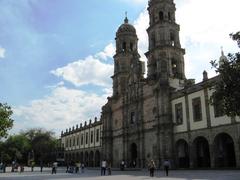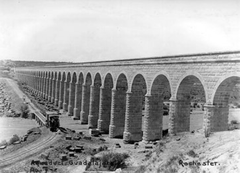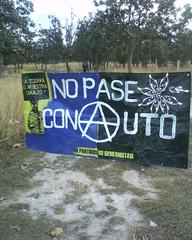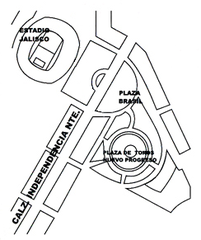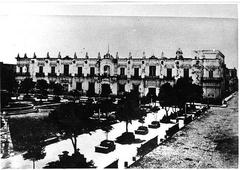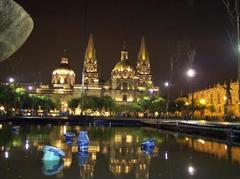Antimonumenta Guadalajara: Visiting Hours, Tickets, and Historical Sites Guide
Date: 04/07/2025
Introduction: What Is the Antimonumenta Guadalajara?
The Antimonumenta in Guadalajara is a powerful emblem of feminist resistance and a site for collective memory, standing in the heart of the city at Plaza de Armas. Since its installation on November 25, 2020—International Day for the Elimination of Violence Against Women—the Antimonumenta has become a focal point for activism, remembrance, and protest against gender-based violence in Mexico, particularly in Jalisco, a state with some of the highest rates of violence against women. Created by local feminist collectives and families of victims, the magenta and purple sculpture featuring the Venus symbol with a raised fist challenges traditional monuments by centering women’s experiences and demands for justice.
Visitors will find the Antimonumenta not only as a striking piece of public art but also as a living, participatory space used for vigils, protests, and community gatherings. Its inscriptions, such as “Ni perdón, ni olvido” (“Neither forgive nor forget”) and “Ni una más” (“Not one more”), alongside memorial installations and a red bench dedicated to victims, invite reflection and engagement with ongoing struggles for gender equality and justice. Its location, surrounded by major cultural landmarks like the Guadalajara Cathedral and the Instituto Cultural Cabañas, makes it accessible to both locals and tourists.
This guide provides everything you need to know about visiting the Antimonumenta—hours, accessibility, events, and etiquette—along with rich historical and cultural context. For the latest updates, follow local feminist organizations and cultural platforms that document the monument’s evolving story (Wikiwand; Milenio; Wikipedia).
Table of Contents
- Introduction
- Origins and Historical Context
- Symbolism and Artistic Features
- Cultural and Political Significance
- Visiting Information: Hours, Admission, Accessibility
- Guided Tours and Events
- Visitor Etiquette and Responsible Tourism
- Nearby Attractions and Cultural Sites
- Ongoing Debates and the Future of the Antimonumenta
- Frequently Asked Questions (FAQ)
- Conclusion
- References
Origins and Historical Context
The Antimonumenta movement began in Mexico City in 2019 when a purple sculpture was installed on the former site of the Christopher Columbus monument as a public demand for justice for victims of gender-based violence. Inspired by this action, similar installations appeared across the country. Guadalajara’s Antimonumenta was placed in Plaza de Armas on November 25, 2020, by local feminist collectives, including families of femicide victims, as an act of protest and remembrance. This grassroots initiative, unsanctioned by authorities, reclaimed a central civic space to amplify voices long marginalized in Mexican public art (Wikiwand; Milenio).
The Antimonumenta also draws from earlier feminist art in Mexico, such as Mónica Mayer’s “El tendedero,” a participatory installation inviting women to share stories of harassment and violence.
Symbolism and Artistic Features
Visual Design
- Shape and Iconography: The sculpture depicts the Venus symbol with a raised fist, a universal image of feminist resistance and empowerment.
- Color: Painted in vivid magenta and purple—colors associated with the feminist movement—symbolizing mourning, loyalty, and defiance.
- Inscriptions: Phrases such as “Ni perdón, ni olvido” and “Ni una más” are emblazoned on the monument, demanding justice and remembrance (Wikiwand).
Dimensions and Materials
- Height: Approximately 3.8 meters tall
- Weight: About 300 kilograms
- Material: Metal, ensuring durability and permanence in the urban landscape (Wikipedia).
Site-Specific Features
- Memorial Bench: A red bench nearby honors victims of gender-based violence.
- Participatory Installations: The “Jardín de la Memoria” (Garden of Memory) and “El tendedero de denuncias y protestas” (Clothesline of Denunciations and Protests) invite visitors to leave testimonies, flowers, and artwork (Milenio).
Cultural and Political Significance
The Antimonumenta serves as both a memorial and an ongoing protest:
- Collective Memory: It honors victims of femicide, including Imelda Virgen and Marisela Escobedo, whose stories are memorialized at the site (Milenio).
- Activism: The monument is a rallying point for protests, vigils, and artistic interventions, especially on International Women’s Day (March 8) and November 25.
- Public Debate: Its placement in a historic plaza sparked debate between activists and local authorities over the use of public space and the importance of confronting gender violence in civic life (Wikipedia).
- Societal Impact: The Antimonumenta challenges traditional narratives in public art, making visible the realities and demands of women in Jalisco and Mexico at large.
Visiting Information: Hours, Admission, Accessibility
- Location: Plaza de Armas, in the center of Guadalajara, coordinates 20.6767° N, 103.3475° W, directly in front of the Palacio de Gobierno, near important sites like the Guadalajara Cathedral.
- Visiting Hours: The monument is outdoors and accessible 24/7. Daytime visits (8:00 AM–8:00 PM) are recommended for safety and to appreciate the monument’s details.
- Admission: Free; no tickets or reservations are required.
- Accessibility: The plaza and surrounding sidewalks are wheelchair accessible, though some cobblestone streets may be uneven (myCityHunt; Lonely Planet).
Guided Tours and Events
- Guided Tours: Several walking tours of Guadalajara’s historic center include the Antimonumenta as a key stop, providing historical and social context (The Crazy Tourist).
- Events: The monument is a gathering point for vigils, protests, and performances, especially on March 8 and November 25. Check local feminist organizations and event calendars for updates.
- Community Engagement: The site often features participatory art and memorial displays, such as flowers, candles, and protest signs (NTR Guadalajara).
Visitor Etiquette and Responsible Tourism
- Respect the Space: Treat the monument and surrounding memorials as sites of remembrance and activism.
- Photography: Allowed—use discretion, especially during events or when photographing people; always seek permission.
- Support Local Voices: Learn about gender violence issues in Mexico and consider supporting organizations like Cladem.
- Minimize Impact: Do not litter or disturb the site; follow any posted guidelines during events.
- Advocacy: Share your experience responsibly on social media, providing context and avoiding sensationalism (ZonaDocs).
Nearby Attractions and Cultural Sites
- Guadalajara Cathedral: Iconic Gothic Revival architecture adjacent to Plaza de Armas.
- Instituto Cultural Cabañas: UNESCO World Heritage site with murals by José Clemente Orozco.
- Rotonda de los Jaliscienses Ilustres: Honors notable figures from Jalisco.
- Palacio de Gobierno: Historic seat of local government.
- Teatro Degollado: Renowned for its neoclassical architecture and cultural performances (Voyage Mexique).
These sites are within walking distance, making for a rich cultural itinerary.
Ongoing Debates and the Future of the Antimonumenta
The permanence of the Antimonumenta is subject to public debate. While some officials initially sought its removal to preserve the historic character of Plaza de Armas, others, including representatives from the Instituto Nacional de Antropología e Historia (INAH), support its continued presence due to its symbolic importance. Activists remain vigilant in maintaining and reinstalling the monument in the face of challenges such as vandalism or removal, highlighting ongoing struggles over public memory and the right to the city (Wikipedia).
Frequently Asked Questions (FAQ)
Q: What are the visiting hours?
A: The Antimonumenta is outdoors and accessible 24/7. Daytime visits are recommended for safety.
Q: Is there an entrance fee or ticket required?
A: No, the site is free to visit.
Q: Where is the Antimonumenta located?
A: Plaza de Armas, Guadalajara’s historic center, near the Cathedral and Palacio de Gobierno.
Q: Is the site accessible for people with disabilities?
A: Yes, Plaza de Armas is wheelchair accessible, but some surrounding streets are uneven.
Q: Are guided tours available?
A: Many walking tours of the historic center include the Antimonumenta; check with local operators.
Q: Is photography allowed?
A: Yes, but be respectful, especially during events or when photographing individuals.
Conclusion
The Antimonumenta in Guadalajara stands as a living testament to the ongoing fight against gender-based violence and the resilience of women and communities in Mexico. Its striking design, central location, and role as a space for activism and remembrance make it an essential visit for anyone interested in social justice, feminist art, or Guadalajara’s cultural heritage. By visiting and respecting the site, you contribute to a growing legacy of resistance, dialogue, and hope for justice and equality (Milenio; Wikiwand; Wikipedia).
For the latest information on events, guided tours, and community initiatives, follow local feminist organizations and cultural tourism platforms. Download the Audiala app for up-to-date guides and interactive maps of Guadalajara’s historical sites.
References and Further Reading
- Antimonumenta Guadalajara: Visiting Hours, History, and Cultural Significance, AWARE Women Artists
- Antimonumenta (Guadalajara), Wikipedia
- Antimonumenta Symbol of the Fight Against Violence, Milenio
- Visiting the Antimonumenta in Guadalajara: Hours, History, and Social Significance, myCityHunt
- Visiting the Antimonumenta in Guadalajara: Hours, Tickets & Visitor Guide, Lonely Planet
- ZonaDocs: Antimonumentos gritan “Ni perdón, ni olvido y castigo a los culpables”
- NTR Guadalajara: Antimonumenta
- Voyage Mexique: Guadalajara
- The Crazy Tourist: Best Things to Do in Guadalajara
